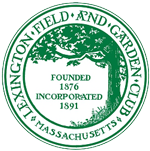LFGC History
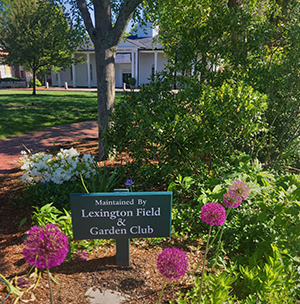
In the mid 19th century, Lexington was primarily a farming community. It began to prosper and develop when the Lexington and West Cambridge Railroad, later the Boston and Maine Railroad, began its service in 1846. By 1886, the Boston & Maine Railroad had opened double tracks to Boston and back and eventually provided train service 22 times a day, each way.
With expansion came new issues, however. In 1875 as the 2,277 Lexingtonians prepared to celebrate the 100th anniversary of the Battle on the Green and welcome Ulysses S. Grant and his cabinet to the festivities, a letter to the relatively new Lexington Minuteman pointed out that the area in front of the railroad depot was most unattractive. It soon became apparent that a permanent association was needed to improve the streets and open spaces, and the Lexington Field & Garden Club (LFGC) was organized. Matthew Merriam was its first president.
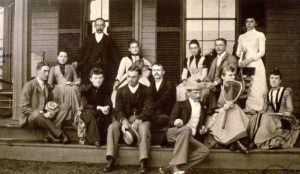 In 1876, the club adopted a constitution that stated, “the object of this association shall be the care and protection of trees and shrubs in the streets and public places of Lexington and the improvement of the town by the planting of additional trees and ornamental plants, the study and development of the natural resources of this vicinity, the cultivation of taste in arboriculture and horticulture and the discussion of these and kindred subjects.”
In 1876, the club adopted a constitution that stated, “the object of this association shall be the care and protection of trees and shrubs in the streets and public places of Lexington and the improvement of the town by the planting of additional trees and ornamental plants, the study and development of the natural resources of this vicinity, the cultivation of taste in arboriculture and horticulture and the discussion of these and kindred subjects.”
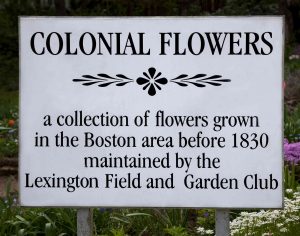 The club was incorporated in 1891. After improving the appearance of the train and freight area, also sought to beautify the islands at Hancock and Bedford Streets, Pleasant and Massachusetts Avenues, and Lincoln and Concord Streets. To this day, the LFGC beautifies these and many other islands. In 1887, it was also willing to assume care of the Common on condition that the town provide $150/year while the club gave $50/year. Under its authority, the hay-covered Common, often filled with cows, became a beautiful historical park.
The club was incorporated in 1891. After improving the appearance of the train and freight area, also sought to beautify the islands at Hancock and Bedford Streets, Pleasant and Massachusetts Avenues, and Lincoln and Concord Streets. To this day, the LFGC beautifies these and many other islands. In 1887, it was also willing to assume care of the Common on condition that the town provide $150/year while the club gave $50/year. Under its authority, the hay-covered Common, often filled with cows, became a beautiful historical park.
Many new technologies, such as commuter trains and trolleys, were improving daily life, yet the increasingly mechanized environment led to social reformers calling for the construction of parks and recommending physical exercise as a way to ward off stress. Enjoying this new focus on leisure, the club members took many field trips to explore their environs.
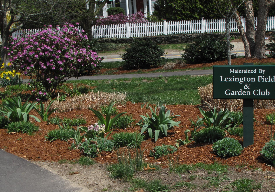 A 36-year old patent attorney, Frederick L. Emery, assumed the presidency of the LFGC in 1904. In September of that year, the Club acquired land now known as Hastings Park and raised the funds necessary to grade and adapt it. During his tenure, Emery began to petition the railroad to sell the land to the town. By late 1921, Boston & Maine agreed to sell it for $20,000. In 1922, the area became known as Depot Square, but after Emery’s death, it was renamed in his honor. In his will he left $5,000 to the town with the income from the bequest to be spent by the garden club to beautify his Lexington.
A 36-year old patent attorney, Frederick L. Emery, assumed the presidency of the LFGC in 1904. In September of that year, the Club acquired land now known as Hastings Park and raised the funds necessary to grade and adapt it. During his tenure, Emery began to petition the railroad to sell the land to the town. By late 1921, Boston & Maine agreed to sell it for $20,000. In 1922, the area became known as Depot Square, but after Emery’s death, it was renamed in his honor. In his will he left $5,000 to the town with the income from the bequest to be spent by the garden club to beautify his Lexington.
Initially and until the 1950s, the men paid dues of $1.00 while the women paid only 50¢. Although the club was founded in 1876, it did not have a female president until Mrs. Hollis Webster was elected in 1933, some 57 years after its founding.
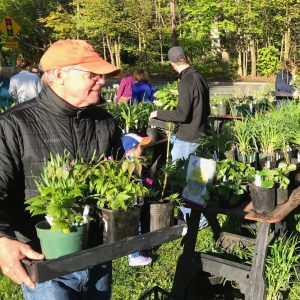 Since 1955, all the presidents have been women, but they were listed with their husbands’ first names – ‘Mrs. John Smith’ – until 1988. Today, you see the LFGC women (and men!) working on the islands, holding the Arbor Day ceremony, or getting ready for their grand plant sale. Looking around Lexington, you see many signs of the club’s work: Captain Parker’s statue, Cary Library Garden, the Hancock-Clarke House Herb Garden, the Munroe Tavern Colonial Flowers and Wildflower gardens, St. Brigid’s Mary Garden, the US Post Office, and the many civic gardens.
Since 1955, all the presidents have been women, but they were listed with their husbands’ first names – ‘Mrs. John Smith’ – until 1988. Today, you see the LFGC women (and men!) working on the islands, holding the Arbor Day ceremony, or getting ready for their grand plant sale. Looking around Lexington, you see many signs of the club’s work: Captain Parker’s statue, Cary Library Garden, the Hancock-Clarke House Herb Garden, the Munroe Tavern Colonial Flowers and Wildflower gardens, St. Brigid’s Mary Garden, the US Post Office, and the many civic gardens.
Members from Lexington and surrounding towns find that the club is a source of friendship and education, while providing an opportunity to give back to their community.

